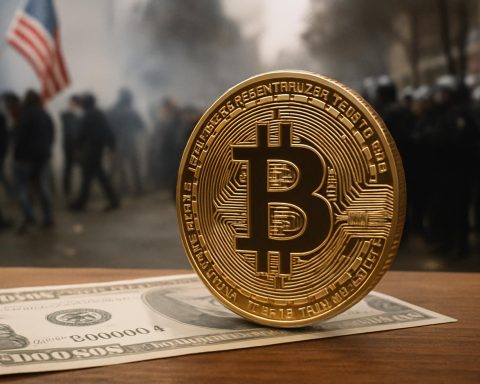- Intel’s (NASDAQ:INTC) stock fell 3% after Taiwan Semiconductor Manufacturing Company (NYSE:TSM) denied collaboration rumors.
- Intel is facing regulatory hurdles, needing special licenses to sell AI chips to Chinese clients amid heightened export scrutiny.
- Investor confidence in Intel wanes, with its share price dropping around 4% this year, currently at $18.76.
- Nvidia (NASDAQ:NVDA) expects a $5.5 billion impact from U.S. export restrictions, causing stock volatility.
- TSM reported positive quarterly results, boosting its shares by 2% and signaling resilience in the chip sector.
- The chip industry is navigating a balance between innovation, regulatory challenges, and investor trust.
The financial storm clouds have gathered over Intel (NASDAQ:INTC), casting a shadow that led to a 3% stock dip on a Thursday morning. The catalyst? A swift denial by Taiwan Semiconductor Manufacturing Company (NYSE:TSM) of any collaborative ventures with Intel or similar entities, refuting swirling rumors of potential joint ventures. This rebuttal comes amidst a backdrop of growing speculation, leaving Intel to navigate through turbulent investor waters.
As whispers of strategic alliances are shot down, Intel faces another formidable challenge – navigating the complex landscape of international regulations. Recent reports indicate that Intel may need special licenses to sell certain high-performance AI chips to Chinese clients. Such regulatory hurdles, arising amid increasing scrutiny over technology exports, play a pivotal role in shaping the techno-economic dynamics between global giants like the United States and China.
Currently trading at $18.76, Intel’s share price reflects a withdrawal of investor confidence, shedding about 4% of its value thus far in the year. Yet, Intel isn’t alone in this slide. The broader chip industry is experiencing mixed fortunes. Nvidia (NASDAQ:NVDA) recently reported it anticipates a hefty $5.5 billion impact from U.S. export restrictions, and its stock is reacting with volatility, extending a 7% drop from Wednesday.
In contrast, Taiwan Semiconductor Manufacturing Company delivered a more optimistic quarterly result, which offered a brief balm to the industry’s collective wounds. Its shares climbed about 2% in a show of resilience, underscoring its pivotal role in the chip supply chain—a sentiment that trickled favorably into the fabric of broader market reactions.
Amid the cacophony of market fluctuations, a vital lesson emerges: confidence and clarity are key in navigating today’s fluctuating market landscapes. As titans like Intel grapple with uncertainty and global regulatory mazes, the chip sector’s pulse remains a measure of delicate balance between innovation, international policy, and investor trust. The journey from speculation to strategy is fraught with challenges, yet it is these very challenges that shape the evolving narrative of tech giants in the 21st-century marketplace.
Intel vs. TSMC Drama: What’s Next for the Chip Industry?
Understanding Intel’s Current Challenges
Intel, known for its significant role in the semiconductor industry, is currently navigating financial and strategic challenges. A key issue is the refutation of potential collaborations with Taiwan Semiconductor Manufacturing Company (TSMC), casting uncertainty over Intel’s future strategies. Here’s a deeper dive into Intel’s situation, coupled with actionable insights and industry predictions.
Navigating International Regulations
A significant challenge for Intel involves obtaining special licenses to sell high-performance AI chips to China. This stems from tighter U.S. regulations on tech exports, reflecting broader geopolitical tensions. These regulations aim to curb technological advances in countries perceived as strategic competitors, impacting companies like Intel.
How-To Steps & Tips to Navigate Regulatory Challenges:
1. Engage in Policy Advocacy: Companies should actively participate in policy discussions to influence favorable regulatory landscapes.
2. Diversify Markets: Expanding into alternative markets can mitigate the impact of export restrictions.
3. Enhance Compliance Mechanisms: Implement robust compliance systems to swiftly adapt to evolving regulations.
Financial Market Impact
Intel’s stock price, trading at approximately $18.76 after a 3% dip, indicates lukewarm investor confidence. It’s not alone; Nvidia and others also face pressures from geopolitical risks and regulatory hurdles. Still, TSMC’s performance showcases resilience, highlighted by a 2% rise following strong quarterly results.
Actionable Financial Tips:
– Portfolio Diversification: Consider balancing investments across various tech sectors to hedge against volatility.
– Monitor Regulatory News: Stay informed on tech policy developments to anticipate market changes.
Key Insights on Industry Trends
Innovation and Strategy
Despite the challenges, Intel is still a leading innovator. The setbacks present an opportunity to rethink strategy, focusing on R&D to strengthen product lines and market presence.
– Invest in AI and Quantum Computing: These are growing fields with vast potential; invest resources to lead innovations.
– Focus on Green Technology: Sustainability is increasingly important; integrating eco-friendly practices can enhance brand value.
Market Forecast and Predictions
The semiconductor industry’s future is a landscape influenced by multi-faceted factors like innovation, regulatory changes, and market demands.
– Short-Term Volatility: Expect continued market fluctuations due to regulatory and geopolitical uncertainties.
– Long-Term Growth Potential: Driven by demands for AI, 5G, and IoT, the industry is poised for growth once current hurdles are addressed.
Pros & Cons Overview
Pros:
– Intel’s commitment to R&D positions it as a front-runner in tech innovations.
– Sector diversification can mitigate risk from single-market dependence.
Cons:
– Regulatory challenges pose serious threats to international sales.
– Competitive pressures from giants like TSMC may affect market share.
Recommendations & Quick Tips
– Stay Informed: Regularly update your knowledge of international tech policies that could impact investments or company strategies.
– Consider Strategic Partnerships: Partner with other industry players on innovation initiatives to share resources and expertise.
– Prioritize Resilience: Build systems that enhance supply chain resilience to withstand global disruptions.
Related Resources
For more insights on global market dynamics and technology, consider visiting Intel and TSMC.
As Intel and its peers navigate these dynamic market conditions, understanding the interplay of innovation, regulation, and investor sentiment is crucial for making informed strategic decisions.










